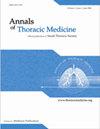中重度外伤性脑损伤患者药物预防时机与静脉血栓栓塞的关系:一项回顾性队列研究
IF 2.3
4区 医学
Q3 CARDIAC & CARDIOVASCULAR SYSTEMS
引用次数: 2
摘要
目的:外伤性脑损伤(TBI)患者发生静脉血栓栓塞(VTE)的风险增加。目前的指南推荐药物预防,但其时间尚不清楚。方法:在这项回顾性队列研究中,2016年至2019年期间入住三级重症监护病房的中重度TBI患者根据药物预防时间分为两组:入院后72小时内给予早期预防和72小时后给予晚期预防。结果:在队列中的322例患者中,46例(14.3%)未接受药物预防,主要原因是早期脑死亡;152例(47.2%)接受早期药物预防,124例(38.5%)接受晚期药物预防。晚期药物预防的预测因子为较低的身体质量指数、脑出血(比值比[OR], 3.361;95%可信区间[CI], 1.269-8.904),出血性挫伤(OR, 3.469;95% CI, 1.039-11.576),血小板计数较低。43例患者在创伤后10天(Q1, Q3: 5, 15)诊断出静脉血栓栓塞:早期预防组为6.6%,晚期预防组为26.6% (P < 0.001)。在多变量logistic回归分析中,静脉血栓栓塞的预测因子为急性生理和慢性健康评估II评分、蛛网膜下腔出血、晚期与早期药物预防(OR, 3.858;95% ci, 1.687-8.825)。晚期预防组气管造口率较高,机械通气时间和住院时间较长,出院格拉斯哥昏迷评分较低,但生存率与早期组相近。结论:在中重度TBI患者中,晚期预防(>72 h)与较高的静脉血栓栓塞率相关,但与较高的死亡率无关。本文章由计算机程序翻译,如有差异,请以英文原文为准。
The association of timing of pharmacological prophylaxis and venous thromboembolism in patients with moderate-to-severe traumatic brain injury: A retrospective cohort study
OBJECTIVES: Patients with traumatic brain injury (TBI) have an increased risk for venous thromboembolism (VTE). The current guidelines recommend pharmacologic prophylaxis, but its timing remains unclear. METHODS: In this retrospective cohort study, patients with moderate-to-severe TBI admitted to a tertiary care intensive care unit between 2016 and 2019 were categorized into two groups according to the timing of pharmacologic prophylaxis: early if prophylaxis was given within 72 h from hospital admission and late if after 72 h. RESULTS: Of the 322 patients in the cohort, 46 (14.3%) did not receive pharmacological prophylaxis, mainly due to early brain death; 152 (47.2%) received early pharmacologic prophylaxis and 124 (38.5%) received late prophylaxis. Predictors of late pharmacologic prophylaxis were lower body mass index, intracerebral hemorrhage (odds ratio [OR], 3.361; 95% confidence interval [CI], 1.269–8.904), hemorrhagic contusion (OR, 3.469; 95% CI, 1.039–11.576), and lower platelet count. VTE was diagnosed in 43 patients on a median of 10 days after trauma (Q1, Q3: 5, 15): 6.6% of the early prophylaxis group and 26.6% of the late group (P < 0.001). On multivariable logistic regression analysis, the predictors of VTE were Acute Physiology and Chronic Health Evaluation II score, subarachnoid hemorrhage, and late versus early pharmacologic prophylaxis (OR, 3.858; 95% CI, 1.687–8.825). The late prophylaxis group had higher rate of tracheostomy, longer duration of mechanical ventilation and stay in the hospital, lower discharge Glasgow coma scale, but similar survival, compared with the early group. CONCLUSIONS: Late prophylaxis (>72 h) was associated with higher VTE rate in patients with moderate-to-severe TBI, but not with higher mortality.
求助全文
通过发布文献求助,成功后即可免费获取论文全文。
去求助
来源期刊

Annals of Thoracic Medicine
CARDIAC & CARDIOVASCULAR SYSTEMS-RESPIRATORY SYSTEM
CiteScore
4.10
自引率
4.30%
发文量
19
审稿时长
>12 weeks
期刊介绍:
The journal will cover studies related to multidisciplinary specialties of chest medicine, such as adult and pediatrics pulmonology, thoracic surgery, critical care medicine, respiratory care, transplantation, sleep medicine, related basic medical sciences, and more. The journal also features basic science, special reports, case reports, board review , and more. Editorials and communications to the editor that explore controversial issues and encourage further discussion by physicians dealing with chest medicine.
 求助内容:
求助内容: 应助结果提醒方式:
应助结果提醒方式:


